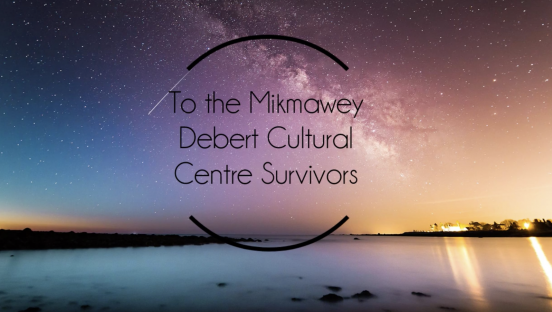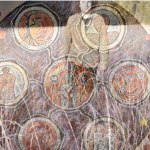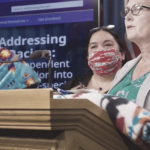The spoken letter that I have created was meant to address the survivors of the Mi’kmawey Debert Cultural Centre. The purpose of this letter is to honour the survivors, their experience and narratives. I used images to portray resilience, heritage, education, and reconciliation. I also used quotes to represent my thoughts and ideas. Finally, I chose a poem that I thought was representative of the negative consequences of colonization, the loss of culture, language and traditions and our human instinct to belong and to connect to our past.
The Art of Resilience
The first artifact used in my spoken letter assignment is that of a flower blooming through concrete pavement. I chose this image for the purpose of conveying resilience, the same resilience that survivors of residential schools have shown throughout their lives. Even though, they have been faced with great challenges, pain and loss, many have found a way to bloom. This picture was acquired through the Art Therapy Spot website which shares messages of resilience through art.
Forgive, Don’t Forget
The next artifact that I chose was a quote by George Santayana.
“Those who cannot remember the past are condemned to repeat it”
This quote speaks to me about the importance of learning from our mistake and the importance of not forgetting our history so that our mistakes are notrepeated again. The more that Aboriginal history is spoken about the more people will understand of their suffering and the injustices that they went through. It is time for Aboriginal history to be taught in schools, to be acknowledged in the workplace, places of worship, and our everyday lives.
The TRC Bentwood Box-A Step Towards Reconciliation
A tribute to residential school survivors, it was created by Like Marston and represents the unique cultures of First Nations, Inuit, and Métis students. The TRC Bentwood box is a reflection of strength and resilience. Its purpose is to serve as a way to commemorate personal journeys toward healing and reconciliation. This picture was acquired from the Truth and Reconciliation Commission of Canada website.
http://www.trc.ca/websites/trcinstitution/index.php?p=42
The Power of Education
I chose this image and quote to demonstrate the importance of education and how it has impacted my life so much. I believe that through my life experiences I have learnt by making mistakes and learning from them, but through education I have learnt by opening my mind to new things and discovering a whole new world.
https://www.quoteslines.com/wp-content/uploads/Education-quotes-the-power-of-education-620×349.jpg
My Heritage
The following picture shows a map of all the Indigenous tribes of Colombia. I am a descendant of the Uitotos and the Andokes tribes (In English: Witotoand Andakies). I wanted to share my own heritage as a way to connect with Aboriginal peoples. Although I didn’t grow up in Canada I grew up in a country that also went through colonization and many injustices and tragedies. I wanted to communicate with the survivors of residential schools that their courage to speak up about their experiences have helped me identify with my own heritage and the damages caused to my ancestors by colonization. This is why I chose the picture with the quote “don’t look at yourself through their eyes”. To me these words represent self-identification and self-worth. Learning to love myself through my own eyes and learning where I come from, who were my ancestors were and what their culture represents.
https://images.8tracks.com/cover/i/009/392/045/tumblr_nmwz5wxZKK1uoycs6o3_540-2719.jpg?rect=0,40,540,540&q=98&fm=jpg&fit=max
Link picture 1: https://linaluna25.files.wordpress.com/2013/02/axd.jpg
Link picture 2: https://images.8tracks.com/cover/i/009/392/045/tumblr_nmwz5wxZKK1uoycs6o3_540-2719.jpg?rect=0,40,540,540&q=98&fm=jpg&fit=max
The Reconciliation Process
I wanted to address the reconciliation process by posting this picture with the quote “Reconciliation is not an aboriginal problem-it is a Canadian problem. It involves all of us” by Senator Murray Sinclair, the first Aboriginal Judge appointed in Manitoba and Canada’s second. I wanted to portray the importance of standing up together as a country united, learning from our past mistakes and supporting Aboriginal peoples. We need to empower Aboriginal peoples in order to address the mistrust and socio-economical inequalities and barriers that prevent us from moving forward as a nation.
https://encrypted-tbn0.gstatic.com/images?q=tbn:ANd9GcR6i6lRMgJ9YqchPCr7YnAGyVS6FtBuaemqRFnNiXGdzCKgYtgw
Link picture 1: https://bbk12e1-cdn.myschoolcdn.com/ftpimages/1091/news/large_news1175889_1131160.JPG
Link Picture 2: https://encrypted-tbn0.gstatic.com/images?q=tbn:ANd9GcR6i6lRMgJ9YqchPCr7YnAGyVS6FtBuaemqRFnNiXGdzCKgYtgw
A Meaningful Poem
Lastly, I chose a poem by Pablo Neruda called “Love America” which to me represents the loss and tragedy caused by colonization, reminisces about man and our connection to earth, to the land and to ourselves. It also portrays the importance of belonging to something bigger and that which unifies us all.
Vivian Ramirez
“Love America”
by Pablo Neruda
Love America (1400) (164)
Before the wig and the frockcoat
There were the rivers, the arterial rivers,
the mountain ranges, in whose weary wave
the condor or the snow appeared unstirring:
the thickness of the humidity, the thunder without a name, the planetary pampas.
Man was earth, a vessel, the eyelid
of the quivering clay, a form from the mud of the earth,
a Carib pitcher, a chibcha stone,
an imperial chalice or an Araucanian silica.
Tender and bleeding he was, but on the hilt
of his moist crystal weapon,
the initials of the earth were
inscribed.
No one
could remember them later: the wind
forgot them, the language of the water
interred, the keys were lost
or inundated by silence or blood.
Life was not lost, pastoral brothers.
But like a savage rose,
a red drop fell to the depths,
and the lamp of the land was extinguished.
I am here to tell history.
From the peaceful buffalo
to the ravaged sands
of the ends of the earth, in the foam
accumulated by the Antarctic light,
and for the burrows embedded off the cliffs
of somber Venezuelan peace,
I searched for you, father of mine,
young soldier of shadows and brass,
or you, nuptial plant, indomitable hair,
caiman mother, metallic dove.
I, Inca from mud,
touched the stone and said:
Who waits for me? And I squeezed my hand
around a fistful of empty glass.
But I traveled among Zapotec flowers
and the light was as gentle as a stag,
and the shade was like a green eyelid.
My earth without a name, without America,
equinoctial stamen, purple spear,
your aroma climbs up my roots
into the chalice I drank, into the finest
word still not yet born from my mouth.





